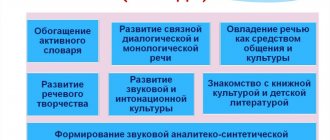Bug
Horned beetles came, solid, rich.
Dynamic pause “The beetle fell” The beetles flew and buzzed: “zh-zh-zh.” (Running with onomatopoeia)
The beetle has fallen and cannot get up. (Lie on your back, swing your arms and legs)
He is waiting for someone to help him. (Adult picks up baby)
Game with buttons "Boots"
Flea beetles came to the fly. They brought her beautiful boots. But the boots are not simple, they have painted fasteners.
Arrange the buttons into circles of appropriate size and color.
Didactic game “Place beetles on flowers”
Tell me what color the beetles are. These beetles love to sit on flowers. But each beetle lands on its own flower - the same color as its own. Place beetles on flowers: red beetles on red flowers, blue beetles on blue flowers, yellow beetles on yellow flowers, green beetles on green flowers.
Application "Ladybug"
Children glue two halves of elytra and a head onto the image of a beetle. Use a black marker to add spots and eyes.
Butterfly
The butterfly flew in. She flapped her wings beautifully.
Look at the picture and show a butterfly that is different from the others, different from other butterflies.
Construction “Fold a butterfly”
In the picture diagram, children lay out an image of a butterfly from geometric shapes. The teacher asks to show the given figure and name its color.
Drawing "Butterfly"
Children paint one butterfly wing, fold it in half, smooth it with their palm, then open it.
Junior group. Early childhood, nursery. Children 1-4 years old
Summary of the open lesson “Insects” (first junior group) Topic: “ Insects ”
Goal: to form a generalizing concept of
“
insects ” .
Objectives: 1) consolidate knowledge about “
insects ” and teach them to recognize;
teach children to distinguish and name colors (yellow, red, blue, green)
; learn to compare objects by size; practice using...
Lesson notes for the second early age group “Insects” Municipal preschool educational institution “Child Development Center - Kindergarten No. 9”
Notes for the OO “Cognitive Development” “Acquaintance with
insects ” Second early age group Volokolamsk, 2021 Purpose: to introduce children with
insects , demonstrate the diagram...
Entertainment for the younger group on the topic: Insects
Summary of entertainment in kindergarten on the topic “Our little helpers.”
Junior preschool age Author: Kameneva Elena Ivanovna Description of the material: This material is intended for educators working with children of primary preschool age. In a playful way, children consolidate their knowledge about insects. Goal: Development of children's cognitive activity through familiarization with the environment. Objectives: Expand and consolidate children’s knowledge about insects, introduce the general concept of “insects” into children’s active vocabulary. Expand children's understanding of the diversity of insects, their characteristic features, and the benefits they bring. Activate cognitive interest in nature and its inhabitants. Develop intelligence and imagination in the process of solving riddles. To instill in children love and respect for the little inhabitants of nature. Equipment: presentation “The Amazing World of Insects”, pictures of insects, flowers of different colors, hoops, two plumes, brushes, glue, blank pictures of insects, “magic meadow”, musical accompaniment. Methods and techniques: visual, verbal, practical: explanation, showing, telling, games and game exercises.
Progress of entertainment
Educator: The world in which we live is bright and wonderful, There are many birds, people, Various insects in the World, Many fish and animals. The world we live in warms us with the sun. To make it comfortable, become kinder to it! The nature of our homeland Russia is rich and diverse. It is home to a variety of animals, birds, and insects. Today we will talk about the amazing, wonderful, beautiful world of insects. Educator: You guys, come over, we’ll go for a walk with you. To visit the insects in the clearing. But the clearing is not simple. It’s a magical clearing. Educator: Oh, look what a beautiful clearing. You like? And to find out who lives in this clearing, you must solve riddles. Puzzles. This cow does not moo and does not knock with its hoof, but crawls along the finger, baby, in a sundress with peas. (ladybug) In a green tailcoat, the maestro flies over the meadow in bloom. He is the pride of the local orchestra and the best high jumper. (Grasshopper) Blue airplane sat on a white dandelion. (Dragonfly) It flutters and dances over the flower, waving a patterned fan. (Butterfly) It’s not a motor, but it makes noise, It’s not a pilot, but it flies. It's not a viper, but it stings. (Bee) He drags the straw to the small house. He is stronger than all the insects. Our hard worker... (ant.) Educator: Children, how can we say in one word about whom we guessed the riddles? Who lives in this beautiful clearing? Children: Insects. Educator: Let's call them affectionately. Game “Name it kindly.” Mosquito-mosquito Beetle-beetle Bee-bee Whiskers-antennae Paw-paws Ant-ant Dragonfly-dragonfly Fly-fly. Educator: Well done! Guys, are there many or few insects on earth? (children's answers) Are many different insects good or bad? (children's answers) What else is good? (it’s interesting to watch them, they are beautiful, they serve as food for others, they are called nature’s little helpers, etc.) What’s bad? (they can sting, interfere with rest, etc.) Educator: All insects are so small that they can be overlooked. But they cannot be offended. What will happen to nature if insects disappear? Plants will disappear and birds will die. Insects are part of nature; you can admire them, watch them fly, run, jump, and buzz. They are called nature's little helpers. Educator: Guys, look, someone flew into our clearing. Z-z-z-z-z. The housewife flies over the clearing, fusses over the flower, and shares the honey. Who is it, children, who flew into the clearing? Children: Bee Teacher: You see, a bee flies from one flower to another. What is she doing? Children: Collects honey. Educator: The bee collects nectar from these flowers. Nectar is a fragrant, sweet liquid. The bee then makes honey from it. Sweet, tasty honey is very useful for children and adults. When we cough, sneeze, or have a sore throat, we can treat ourselves with honey. And now we will play with you. You will be the bees. Outdoor game: “Find yourself a flower.” Flowers are arranged in a circle. Children perform movements in accordance with the text. Educator: The bees flew, fluttered over the flower. (Children slowly run on their toes one after another around the flowers). We sat down, sat, and rested. (The children sat down and shook their heads) They flew on (The children stood up, waved their hands, and ran on).
Educator: Guys, a cow came to visit us, but this cow is not an ordinary cow. This cow does not moo and does not knock with its hoof, but crawls on your finger, baby, in a sundress with peas. Educator: What kind of cow is this (children's answers). That's right, ladybug. Look how beautiful she is! Look what color it is? What color are the dots on it? Right! Her outfit is red, and there are many dots on it - they are black. And under a beautiful bright outfit the ladybug hides her wings. And the ladybug also benefits the forest. She and her larvae destroy the nasty green aphids that live on the leaves and suck the sap from the plants. Ladybugs are protectors of plants, trees, and forests. Educator: Let's turn into ladybugs. Physical education They circled around themselves and turned into ladybugs (Spin around). Ladybugs, show your heads, noses, mouths, wings - arms, legs, tummies. (Show named body parts) Ladybugs, turn their heads to the right, Ladybugs, turn their heads to the left. (Turn your head to the right, left) Stomp your feet, flap your wings. (They stomp their feet. They clap their hands) They turned to each other and smiled sweetly. (Turn and smile)
Educator: Guys, someone else is in a hurry to our clearing. He is a real worker, very, very hard-working. Under a pine tree in a dense forest, he builds a house from needles. Who is this? Educator: That's right, guys, it's an ant. The hasty ants are not lazy, not stupid. Grains and crumbs are dragged along the path one after another. Ants cannot be lazy, ants live by work: Everything they see, they drag into their underground home. Educator: Look how big their house is. It is called an anthill. Let's repeat it all together - an anthill. On a bright, sunny day, work is in full swing here. The ants are in a hurry somewhere, hurrying, entering and exiting through round holes-gates to the surface. Ants are small but hardworking. Oh, a bird has flown to an anthill. Why do you think she is sitting on the anthill? Educator: Children, ants heal birds. They push out small bugs from her wings that bother her. Ants are useful inhabitants, they are forest orderlies. Therefore, anthills cannot be destroyed. Outdoor game “Ants and Rain” Children - “ants” sit in hula hoop houses. On the other side there is a child sitting - “rain”. The “rain” is dozing, the “ants” are scattering in different directions. At the command: “It’s starting to rain!”, the ants run to their houses, and the “rain” tries to hit everyone with its plume (“wet”). Those who were touched by the “rain” with their hands are eliminated from the game. The game continues until the most dexterous “ant” remains.
Educator: The world of insects is beautiful and diverse. I ask you to come to the table. I want our clearing to come to life. I suggest you decorate it with insects. Take insects, name them and place them in a clearing. “Decorate the clearing with insects.”
Educator: Look how beautiful the clearing has become. Let the ants and beetles crawl, let the grasshoppers jump, let the butterflies and dragonflies fly! After all, they are all our little helpers. They need to be protected; they bring benefits to nature. Don't hurt insects! By protecting them, we protect nature!
We recommend watching:
Musical entertainment for children of the 2nd junior group. Scenario Physical education “Journey to Lesovichok” Musical entertainment for children of early preschool age Sports and game entertainment for children of the first junior group
Similar articles:
Scenario of musical entertainment “In a flower meadow” for the younger group of kindergarten
Progress of the lesson:
The sun woke up early and came to visit us in the morning. He smiled at all the guys and wished everyone well.
Game situation “Birthday Fly”
There will be, there will be children having fun until the morning. Today it's the Birthday Fly Tsokotuha!
Today we are going to visit the Tskotukha Fly. She is the birthday girl today - her birthday is today. And besides us, a variety of guests will come to the fur for the holiday. And here they are.
Next, the teacher shows the picture of “Guest”, names the insect depicted on it and asks to repeat it. After the children complete all the tasks related to this particular “guest,” the teacher asks the children to name him again.
Mosquito
That's a good mosquito, He's a daring mosquito. He flew to visit the fly and danced very merrily.
Didactic game “Find a paired picture”
Find a picture exactly like yours.
Dynamic pause “Mosquitoes”
Here are the mosquitoes sitting (Sit on the carpet)
They look in different directions. (Turn left and right, place palm to forehead)
Wanted to frolic (Get on your feet)
They flew off one after another. (Running in circles one after another)
They sang along the mosquito line: “z-z-z.” (Onomatopoeia)
Spider
I'm a spider, not evil at all. I don't eat beautiful flies.
Game with clothespins "Spider"
Use clothespins to make spider legs.
Exercise "Web"
The bug flew and flew and came across a web. Lay out the web mesh in front of you. Place the bug in the middle. Fold the web, unfold it. Move the bug to the web paradise. A bug escapes and flies away - lift the bug up.
Exercise “Dew on the Web”
It rained and droplets remained on the spider's web. Place the drop stones on the web.
Dynamic pause “A spider crawls along a branch”
A spider crawls along a branch, and all the children crawl behind it. (Arms are crossed, the fingers of each hand “run” along the forearm, and then along the forearm of the other hand)
Rain suddenly fell from the sky and washed the Spider to the ground. (Brushes are freely lowered, perform a shaking movement. Then clap on the table, knees)
The sun began to get hot. The spider crawls again. (Palms with spread fingers look to the sides)
And all the kids crawl behind him (Same as in the beginning. “Spiders” crawl up - onto their heads)
To walk along the branch. (Run fingers through hair)
Caterpillar
The caterpillar was crawling. I was surprised by the transformation.
Game with laces “Caterpillar”
Insert the string into the hole, thread it through and wrap it around the track. This is how the caterpillar prepares to become a butterfly.
Musical break "Butterfly"
Children perform movements according to the words of the song: they tear off pieces from a leaf cut out of green paper, lie down on the carpet, run, and wave the crayfish.
Didactic game “The caterpillar became a butterfly”
So the caterpillars became butterflies. Arrange the butterflies on top of the caterpillars correctly: the yellow caterpillar became a yellow butterfly, the red caterpillar became a red butterfly, the blue caterpillar became a blue butterfly, and the green caterpillar became a green butterfly.



